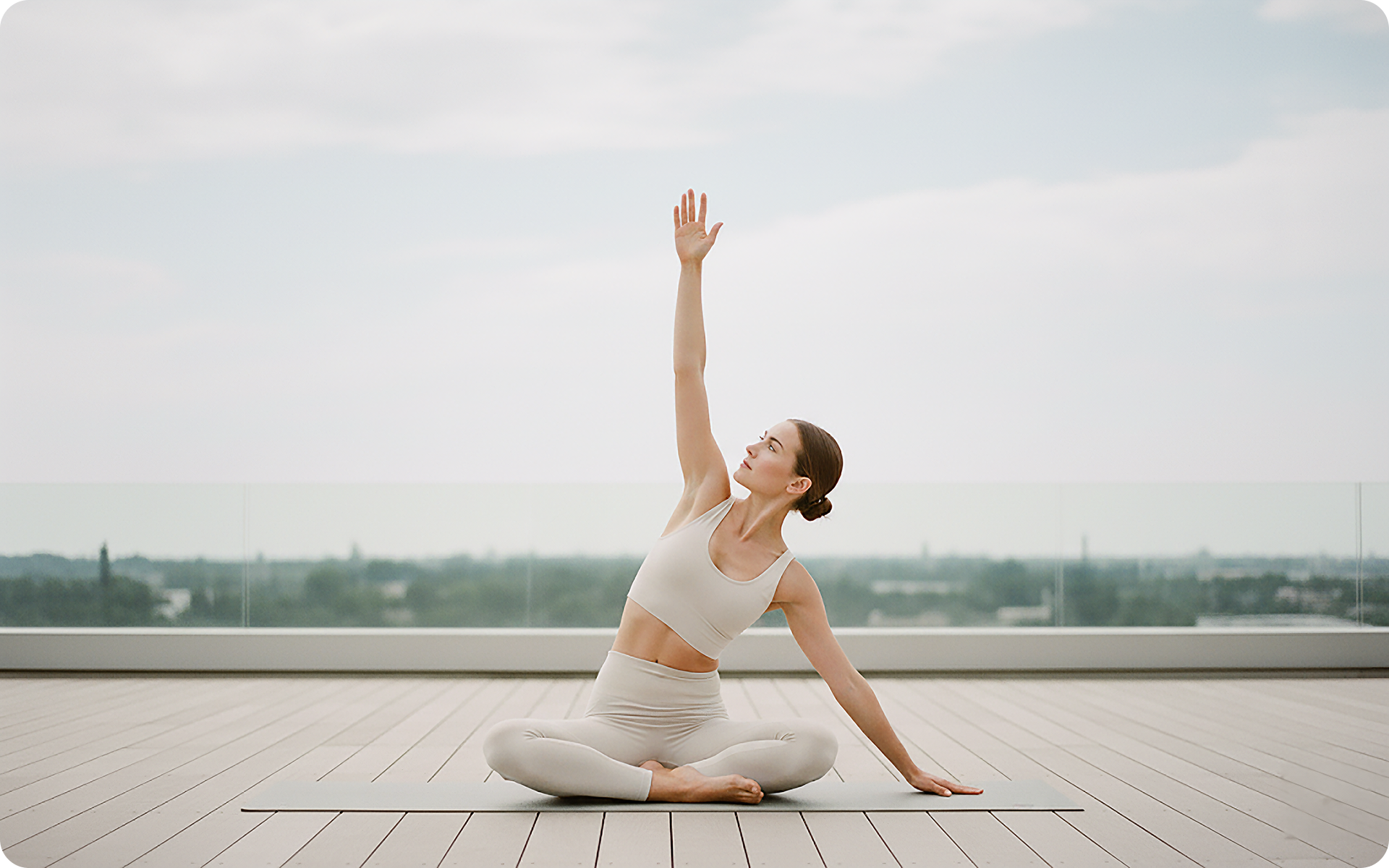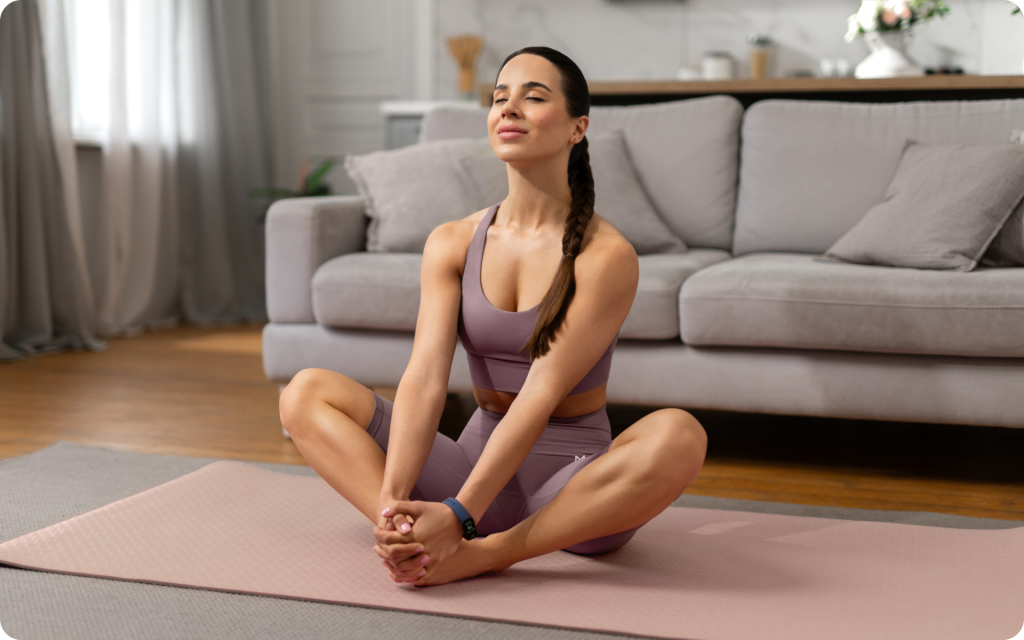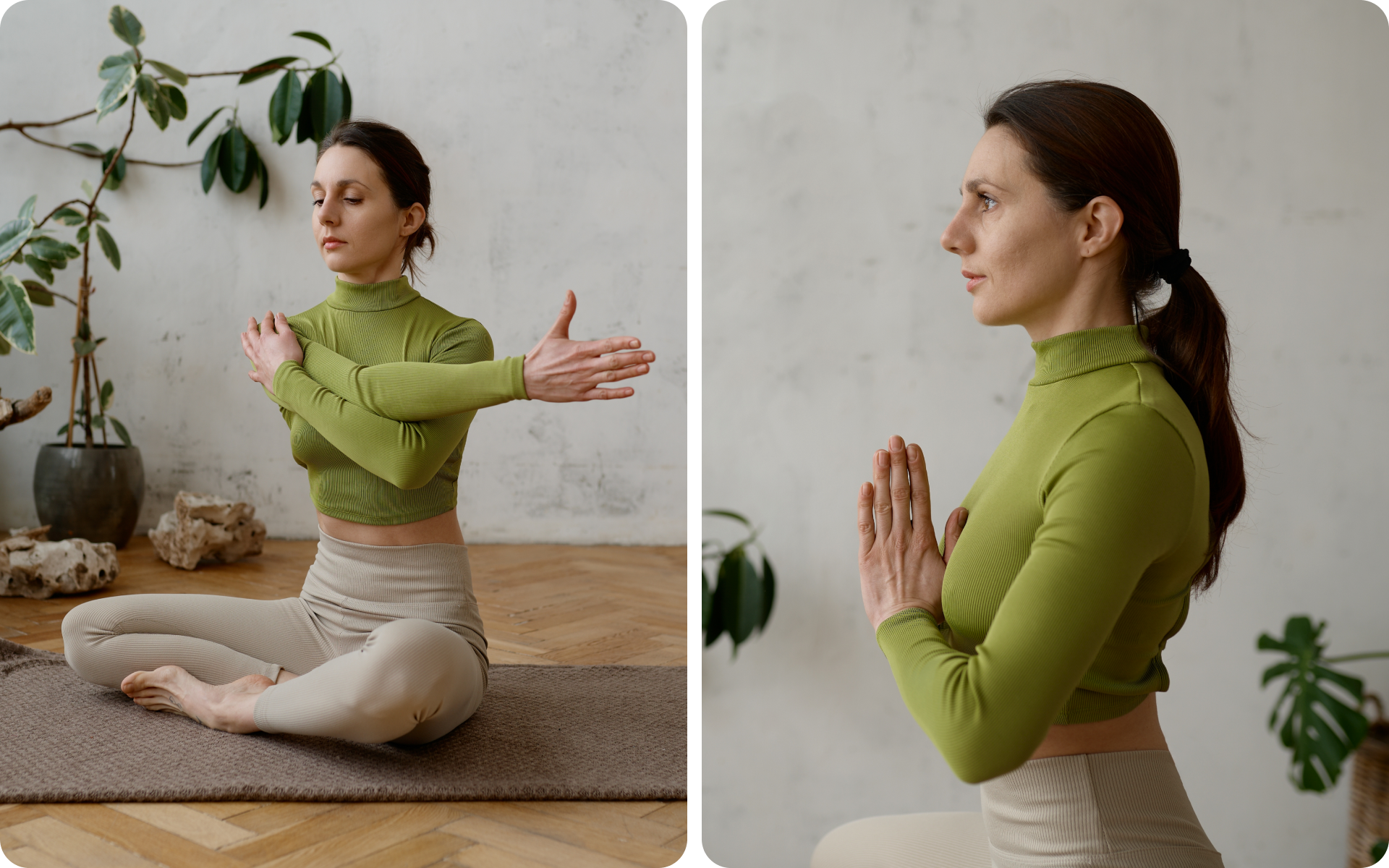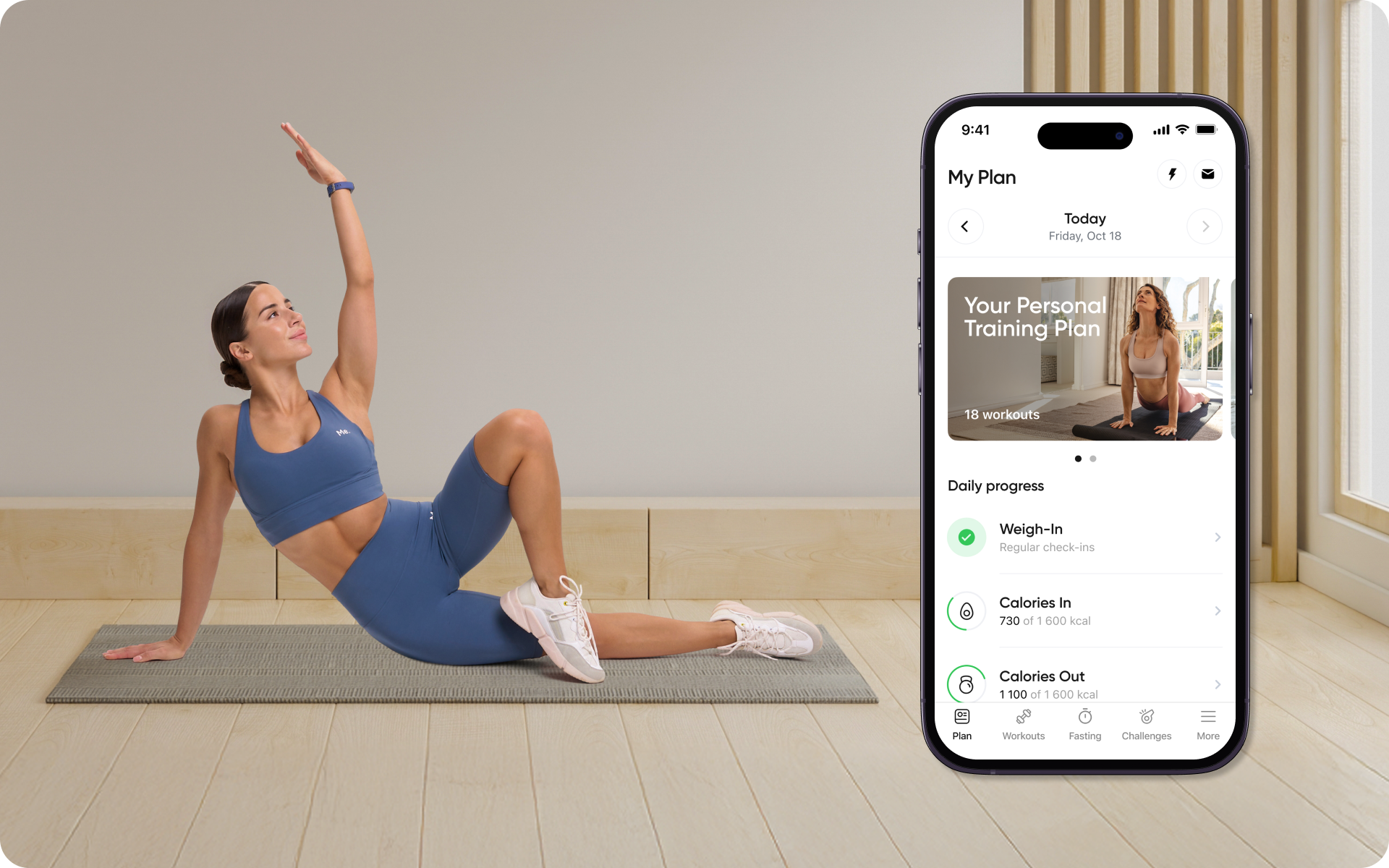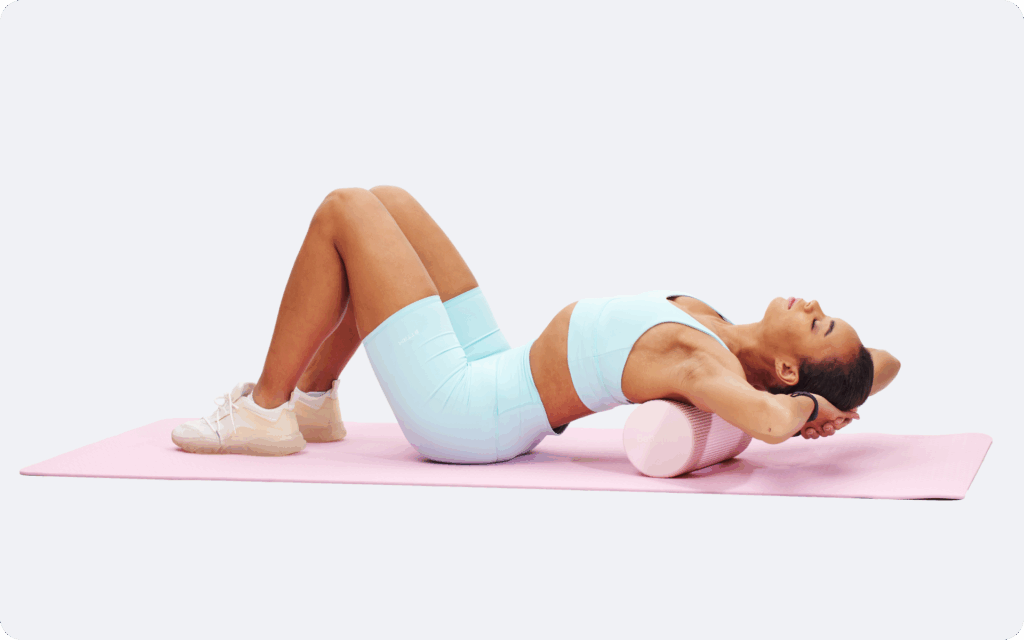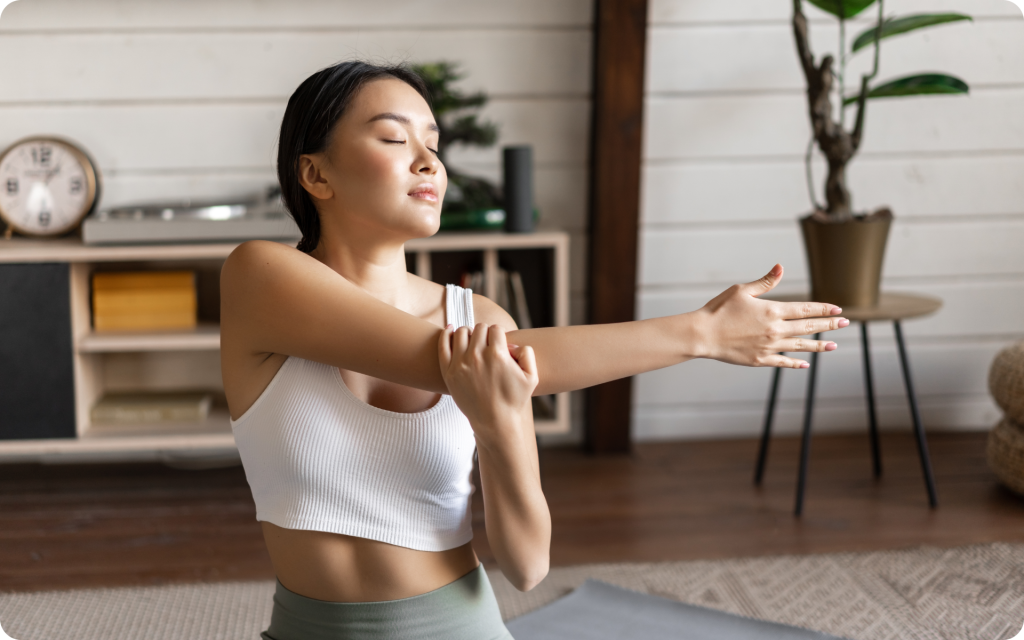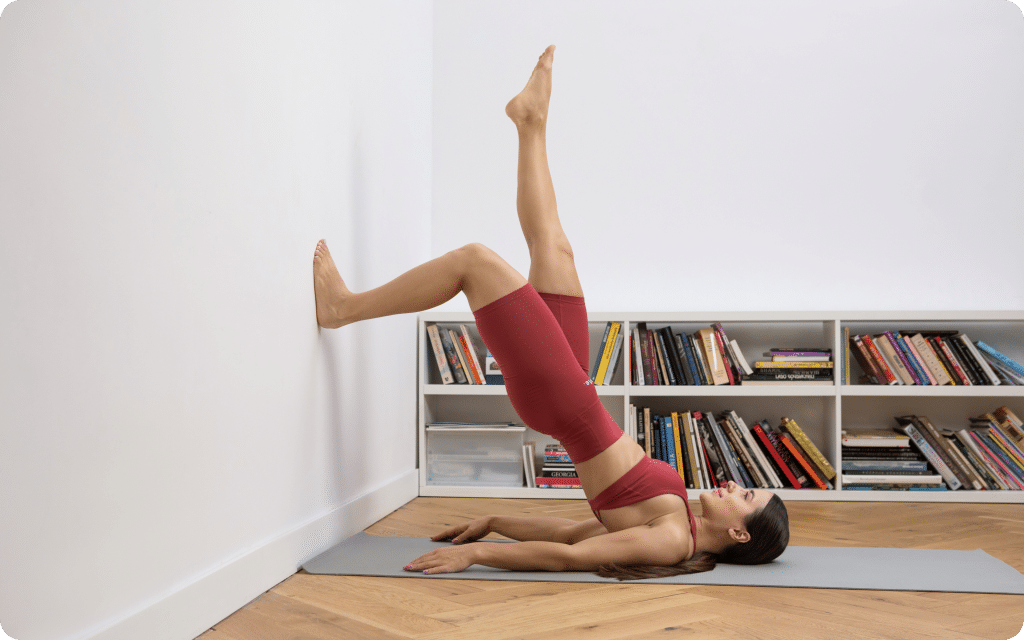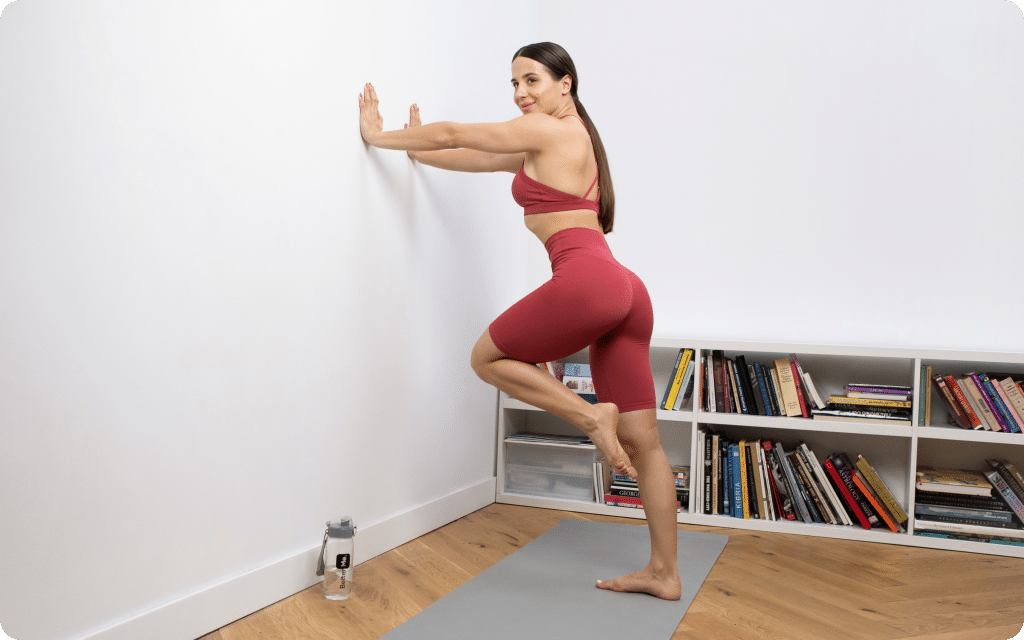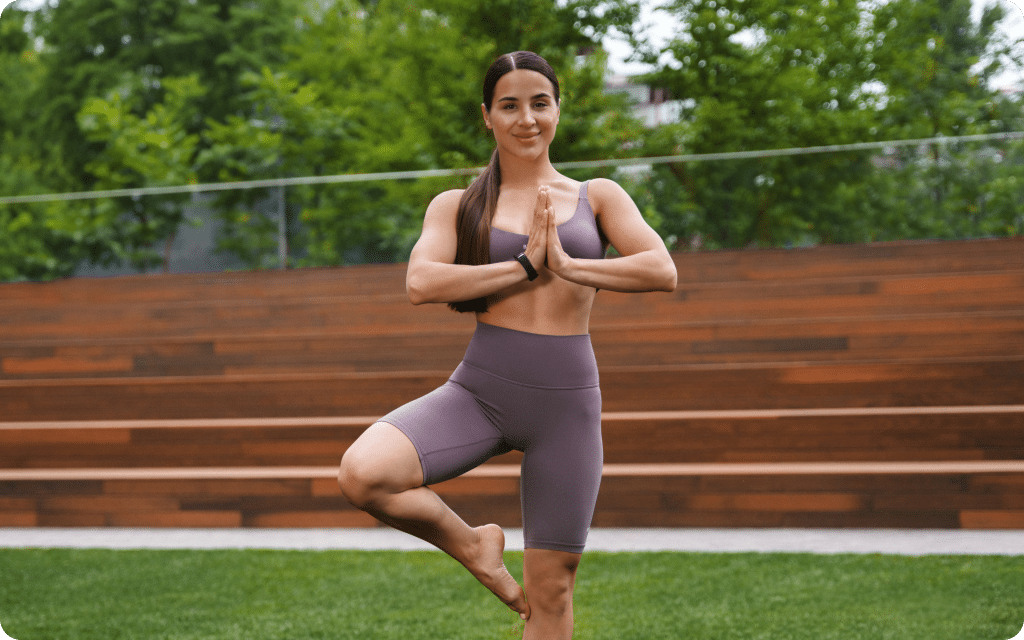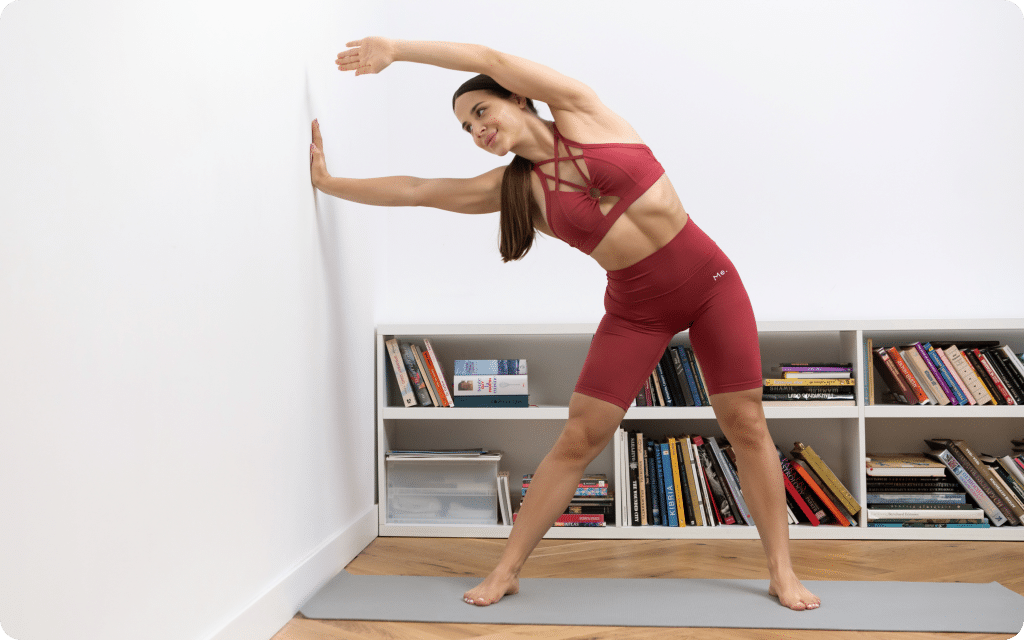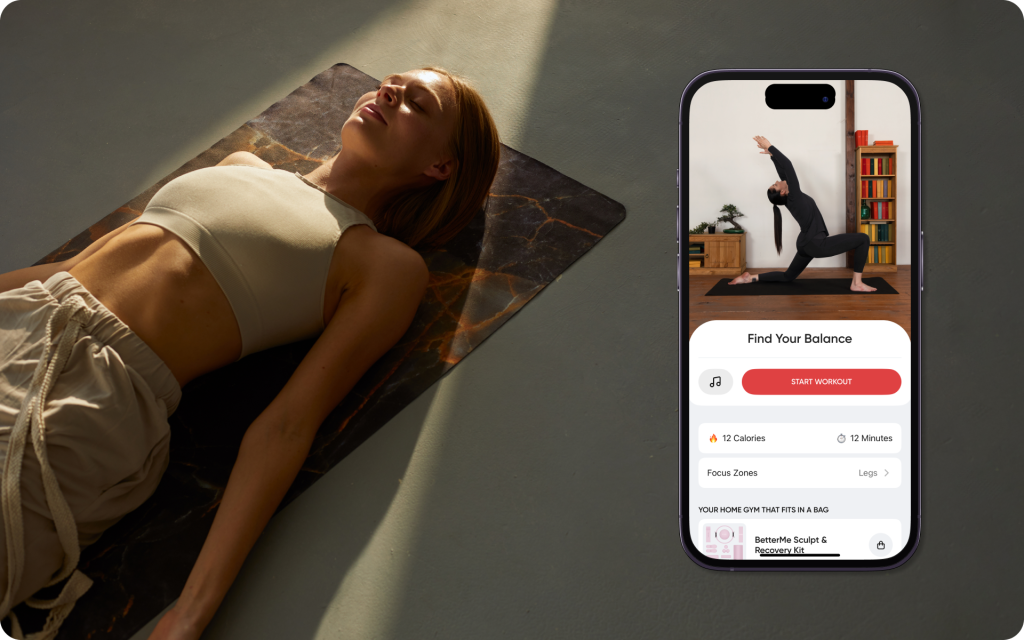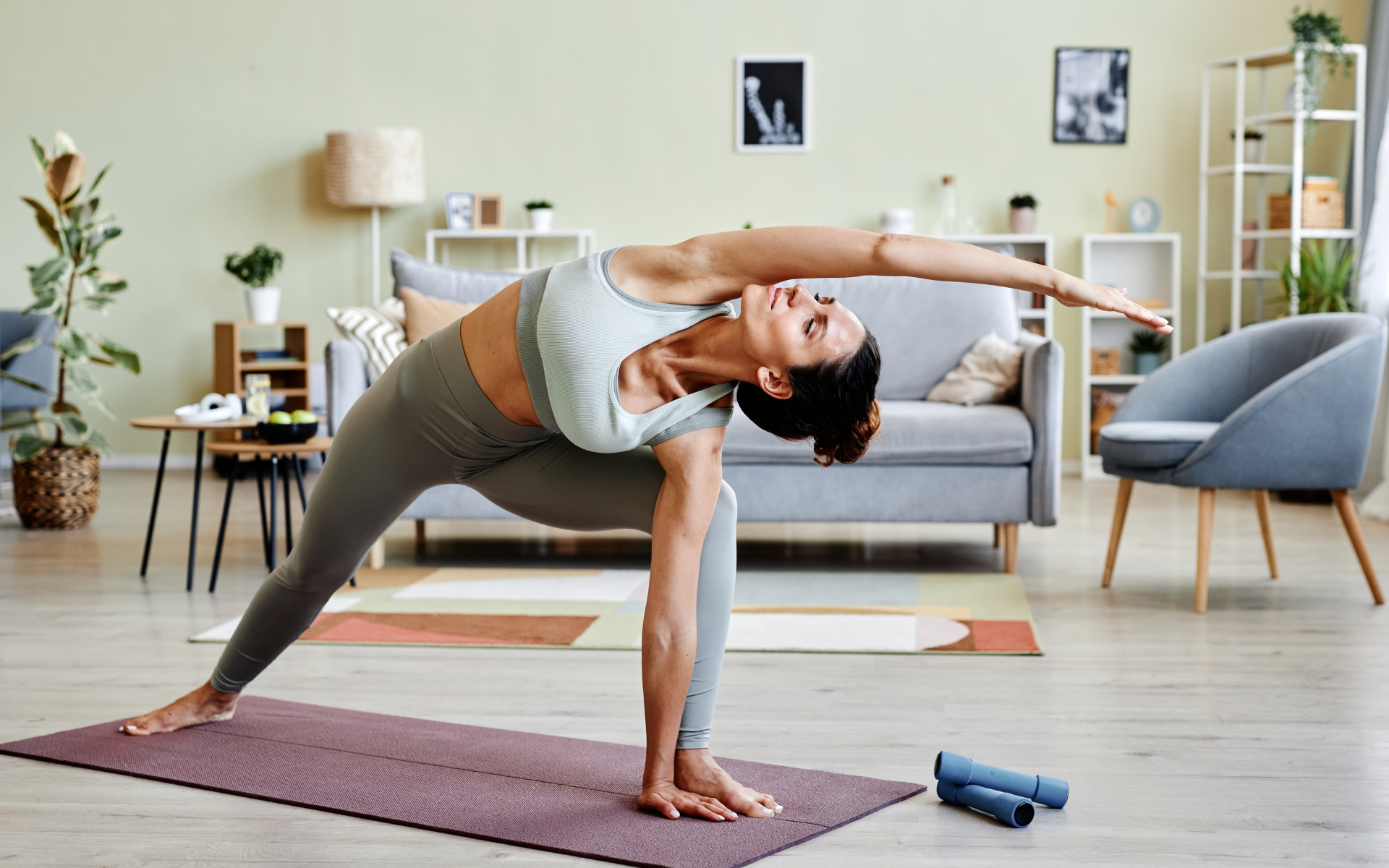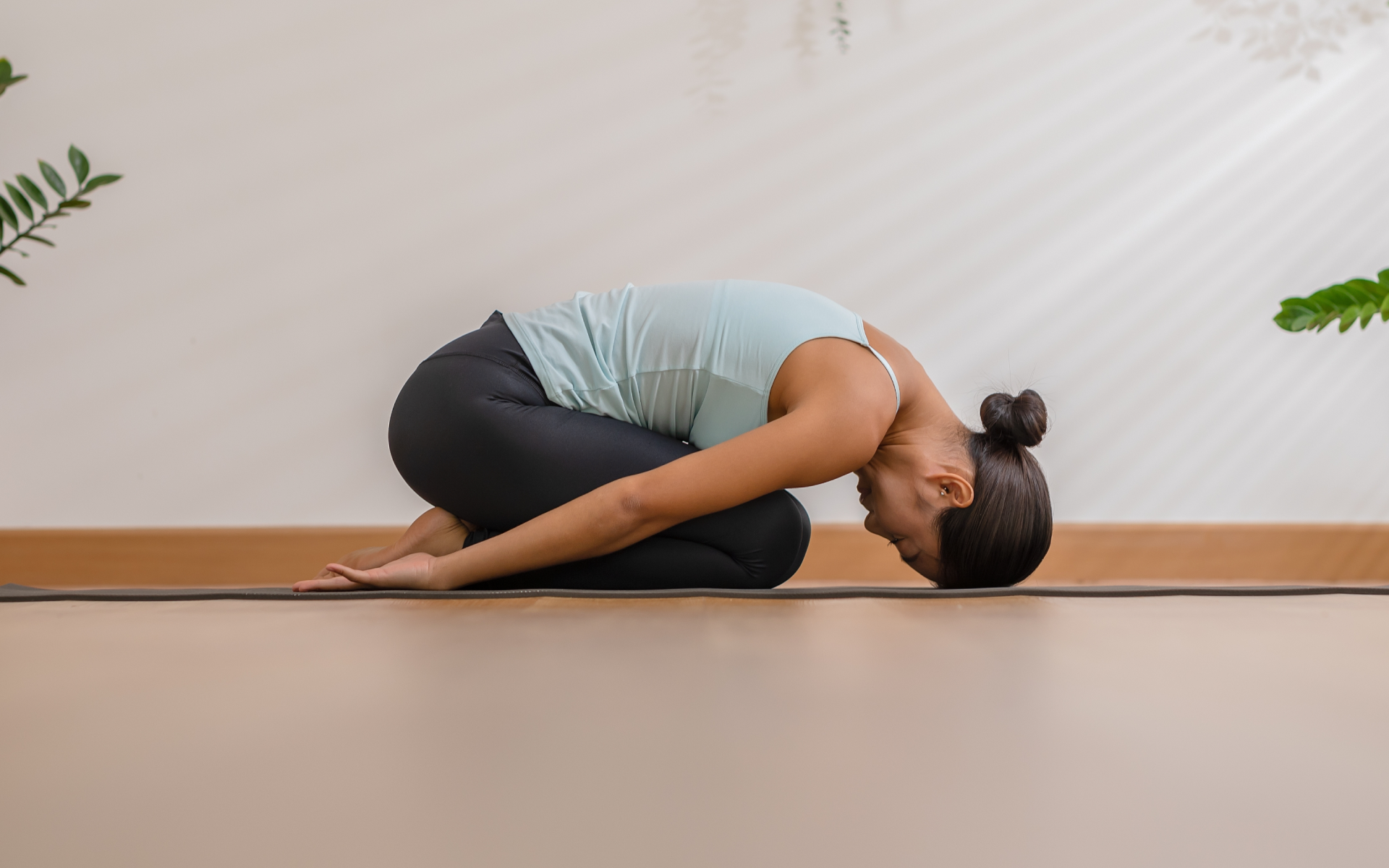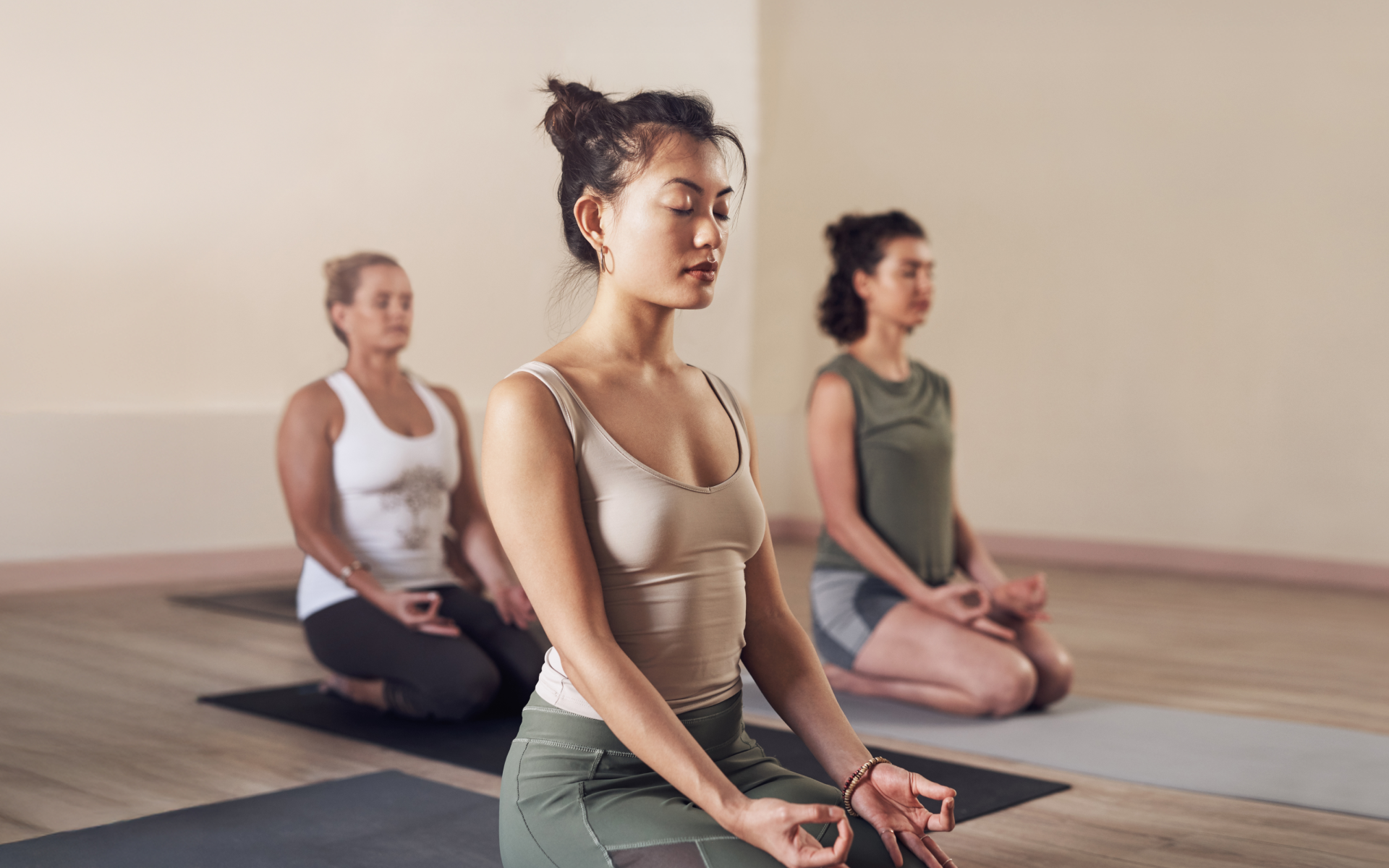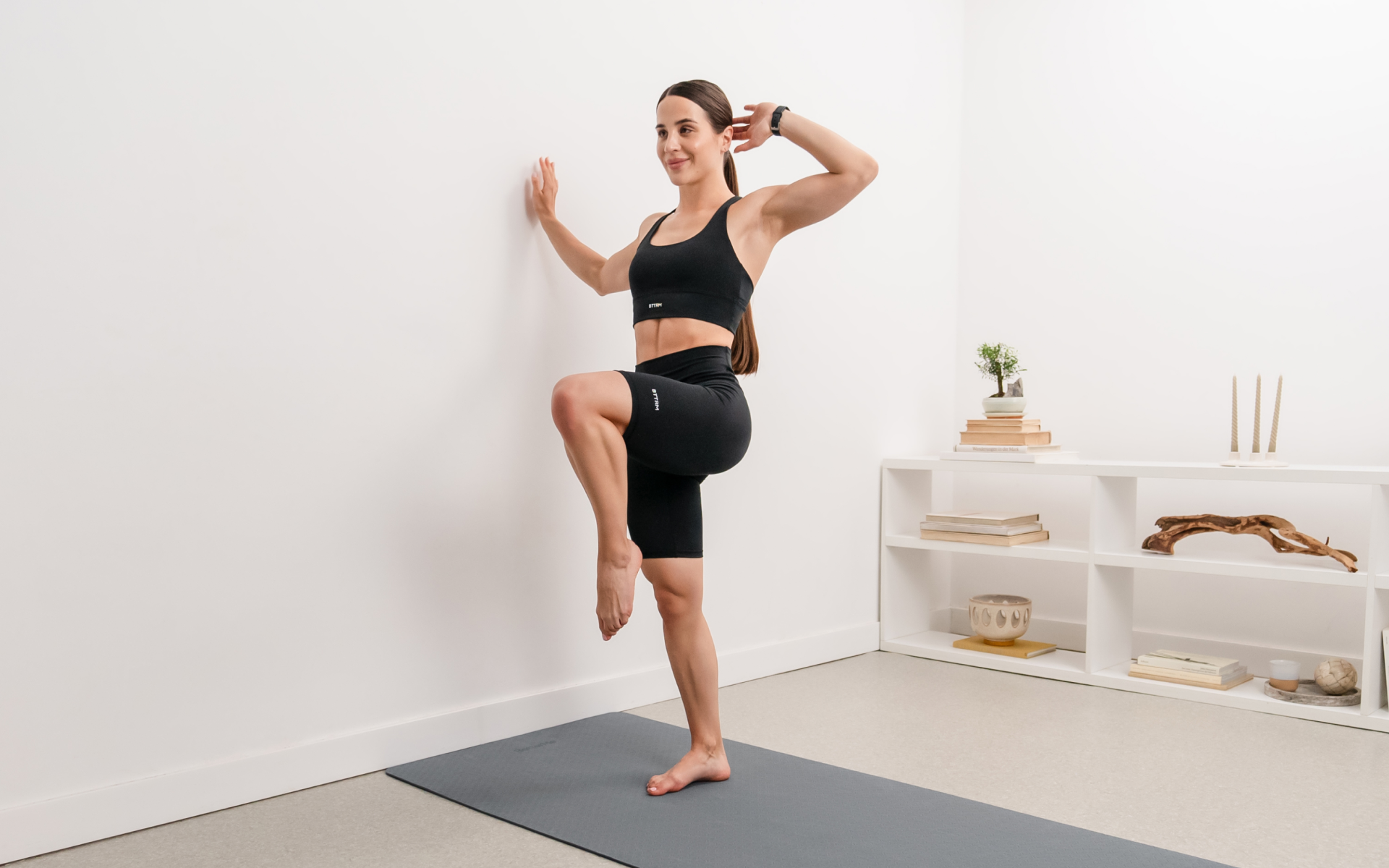On one hand, there’s an introspective approach to Pilates that we might call somatic Pilates. This isn’t a formally categorized method, but it describes incorporating principles of somatic awareness into your practice. Here, the focus shifts inward, emphasizing how your body feels in motion. This requires tuning into sensations, releasing unnecessary muscle tension, and moving with awareness of your posture and breathing patterns (1).
On the other hand, we have wall Pilates. This incorporates the stability and support of a wall into traditional Pilates exercises. The wall becomes a tool to both challenge and guide your movements, offering resistance or assistance depending on the exercise. It often provides a more structured and externally guided experience.
Here, we’ll compare the two to help you decide which is best for you.
What Is the Difference Between Somatic Pilates and Wall Pilates?
Both somatic Pilates and wall Pilates offer unique benefits and approaches to movement and self-care. While they share common Pilates principles such as core engagement, alignment, and controlled movement (2), they differ significantly in terms of how they engage the body and mind. Below, we’ll break down their distinctions under several key categories.
- Focus
One of the most important differences lies in their focus.
Somatic Pilates trains your attention inward. The movements are guided by your internal sensations, which makes you aware of any tension, imbalance, or discomfort present in your body (3). The goal is to refine your awareness, helping you adjust your posture and movement patterns instinctively. It’s about building a deep, personal connection with your body through mindful exploration.
In contrast, wall Pilates shifts part of the focus to external structure. By using the wall as a point of resistance and support, the practice encourages physical precision and alignment. The wall provides a tactile reference, which helps you achieve proper form. While wall Pilates undoubtedly requires concentration, its focus is more structural and targets strength and alignment through external feedback.
- Movement Approach
Practicing Pilates somatically is fluid and instinctive. It emphasizes moving at your own pace, guided by how your body feels. Somatic movement often starts with slow, simple sequences that allow you to explore subtle shifts in muscle engagement and joint mobility. Over time, these movements become a natural extension of your daily activities (4).
On the other hand, wall Pilates has a more pre-defined structure. Exercises often follow specific frameworks that incorporate the wall’s support to enhance resistance and stability. Movements are typically more mechanical, with a stronger emphasis on precision and adherence to set patterns.
Both approaches can improve function and form, but somatic Pilates prioritizes organic, exploratory movement, while wall Pilates prioritizes structured form.
BetterMe: Health Coaching app helps you achieve your body goals with ease and efficiency by helping to choose proper meal plans and effective workouts. Start using our app and you will see good results in a short time.
- Tools and Feedback
Somatic Pilates is reliant on minimal external support. The feedback comes from within, requiring a heightened sense of proprioception (your awareness of your body in space). This allows you to rely on your internal cues to correct and refine movements (4). The process can highlight areas of tension or asymmetry, which helps you address them independently.
Wall Pilates, as the name suggests, uses the wall as both a tool and a guide. The wall provides external support that enhances balance, stability, and resistance. This tactile feedback makes it easier to maintain alignment and gauge progress in strength-building exercises.
This distinction is essential. Somatic Pilates nurtures what we call “internal self-feedback,” while wall Pilates gives you “external reference points” for alignment and control.
- Outcomes
The outcomes of these practices reflect their unique nature.
With somatic Pilates, the benefits extend beyond physical performance. You develop a deep sense of body awareness and improved neuromuscular control. Over time, this translates to better posture, reduced chronic tension, and more mindful movement throughout your day (5).
Wall Pilates delivers results that are often easier to quantify. It strengthens specific muscle groups, enhances alignment, and builds stability using gravity and resistance. It’s particularly practical for those who want a functional, equipment-free workout or who require additional support, such as beginners or those who are rehabilitating from injuries (6).
Both can enhance strength, flexibility, and movement quality, but somatic Pilates leans toward long-term, internal transformation, while wall Pilates offers tangible, immediate tools for strength and alignment (7).
Read more: Somatic Yoga Routine: A Path to Better Mind-Body Balance
Is Somatic Pilates the Same as Wall Pilates?
Somatic Pilates and wall Pilates aren’t the same, but they aren’t mutually exclusive either.
“Somatic Pilates” isn’t a categorized practice like classical or reformer Pilates. Instead, somatic principles can be incorporated into any Pilates routine, even wall Pilates.
Somatic principles emphasize internal awareness, focusing on how your body feels during movement rather than simply following preset patterns (1). This mindset can transform your experience of Pilates by making you more mindful of posture, breath, and the release of unnecessary tension.
When you practice wall Pilates, it’s possible to approach the exercises somatically. For example, you can pay close attention to how your body engages with the wall, noticing areas of effort or strain. Rather than rigidly adhering to external form, you can use the wall as a guide to refine movement based on your body’s internal cues. This allows you to address habits such as overusing certain muscles or neglecting proper alignment.
The key difference lies in how you direct your attention. Wall Pilates generally focuses on external alignment and structure, but integrating a somatic approach will add an inner awareness that enhances the practice. You shift from simply “doing” the exercises to fully experiencing them, which can lead to a deeper, longer-lasting connection with your body.
Which Is Harder, Wall Pilates or Somatic Pilates?
The difficulty of any practice largely depends on what you find personally challenging. Wall Pilates and somatic Pilates demand different types of effort, so “harder” often comes down to how your body and mind respond to their unique demands.
Wall Pilates can be physically demanding. It uses the wall as a resistance tool, which allows you to target and strengthen specific muscle groups. Holding postures, maintaining control, and pushing against resistance can build strength and stability. If you’re unused to these physical demands or have weaker stabilizing muscles, wall Pilates may feel more intense.
On the other hand, somatic Pilates challenges your mental focus and neuromuscular control. It’s not about pushing muscles to their limits, it’s about refining how they engage (8). You’ll need to pay close attention to subtle sensations, which requires a great deal of focus and patience. For some people, this inward awareness can be challenging, particularly if they’re accustomed to fast-paced or high-intensity activities.
Reasons why BetterMe is a safe bet: a wide range of calorie-blasting workouts, finger-licking recipes, 24/7 support, challenges that’ll keep you on your best game, and that just scratches the surface! Start using our app and watch the magic happen.
Which Type of Pilates Is Best for Weight Loss?
Weight loss fundamentally relies on maintaining a calorie deficit, which means you burn more calories than you consume (9). Neither wall Pilates nor somatic Pilates alone will directly lead to weight loss unless it’s combined with appropriate nutrition and additional physical activity.
That being said, these forms of Pilates can support weight loss indirectly:
- Wall Pilates: Its structured strength training can increase muscle tone. The more muscle you have, the higher your resting metabolic rate, which helps you burn more calories, even when you’re at rest. These workouts may also include dynamic, high-effort sequences that raise your heart rate, which contribute to calorie burn during the session.
- Somatic Pilates: While it’s less physically intense, somatic Pilates can help relieve physical tension and improve movement efficiency. For example, if tight muscles or improper movement patterns cause you discomfort during exercise, addressing these issues will let you move freely and engage in activities that burn more calories, such as walking or running.
Ultimately, the best Pilates for weight loss is that which you enjoy and can sustain. Pairing any type of Pilates with cardiovascular exercises such as walking, running, cycling, or swimming will enhance its weight loss potential.
Our previous post goes into great detail about the best somatic exercise program.
Is Somatic Pilates or Wall Pilates Better to Build Glutes?
Gluteal muscle development requires progressive overload, which means your muscles need to face increasing levels of resistance over time (10). With this in mind, wall Pilates is better suited for directly building the glutes.
Wall Pilates includes targeted glute-strengthening exercises, such as bridges, squats, or leg lifts, which often incorporate resistance from body weight or gravity. Using the wall for alignment and resistance allows for a more focused approach to glute engagement. You can progressively increase the challenge by adjusting angles or holds, providing the necessary stimulus for growth (10).
Somatic Pilates, on the other hand, focuses on movement quality and neuromuscular awareness. While this doesn’t directly build glute strength, it can enhance how effectively your glutes activate. You may discover areas where your glutes aren’t engaging fully and learn to correct that muscle pattern. Over time, this improved activation can enhance the results of more traditional strength-building exercises (11).
Read more: Wall Pilates for Weight Loss: Does It Work?
What Are Some Somatic Pilates vs. Wall Pilates Exercises?
Both somatic Pilates and wall Pilates offer meaningful exercises that are tailored to their unique principles. Below, you’ll find examples of exercises from each approach, which are explained with clear, numbered steps. These exercises are designed to help you better understand how each practice engages your body and mind.
Somatic Pilates Exercises
Somatic Pilates focuses on internal awareness, gentle movement, and releasing unnecessary tension. Here are two exercises you can explore.
1. Pelvic Clock
This exercise builds pelvic mobility and awareness of tension in the lower back, hips, and core.
Steps:
- Lie on your back with your knees bent and your feet flat on the ground, hip-width apart.
- Imagine your pelvis as the face of a clock, with your navel as 12 o’clock and your tailbone as 6 o’clock.
- Slowly tilt your pelvis toward 12 o’clock by engaging your lower abdominal muscles, feeling your lower back press gently into the ground.
- Shift your pelvis toward 6 o’clock by arching your back slightly and tipping your tailbone downward.
- Continue this slow movement, and as you gain comfort, shift your pelvis in the direction of 3 o’clock (left hip) and 9 o’clock (right hip).
- Repeat this for approximately 2-3 minutes, focusing on smooth, controlled circles and internal sensation.
2. Somatic Shoulder Rolls
This exercise improves shoulder mobility and relaxes upper-body tension.
Steps:
- Sit comfortably on the floor or in a chair, keeping your spine tall.
- Slowly shrug your shoulders toward your ears, noticing any areas of tightness.
- Roll your shoulders back, feeling the movement in the shoulder blades, and return them to their neutral position.
- Gradually explore rolling your shoulders forward. Keep the movement slow and deliberate, tuning into sensations in the muscles and joints.
- Repeat for 1-2 minutes, alternating between directions, ensuring your breath remains natural and steady.
Wall Pilates Exercises
Wall Pilates emphasizes external support and resistance, targeting strength, alignment, and flexibility.
1. Wall Bridge
This classic exercise strengthens the glutes, hamstrings, and lower back while promoting spinal alignment.
Steps:
- Lie on your back with your legs bent and your feet flat against the wall, with your knees at a 90-degree angle.
- Position your arms at your sides, your palms facing down.
- Press your feet into the wall as you slowly lift your hips toward the ceiling, engaging your glutes and core.
- Pause briefly at the top, ensuring your body forms a straight line from shoulders to knees.
- Lower your hips back down in a controlled motion.
- Repeat for 8-12 repetitions.
2. Wall Plank
This builds core strength and stability while using the wall for alignment feedback.
Steps:
- Stand facing the wall with your palms pressed against it, your shoulders at a comfortable height.
- Step your feet back until your body forms a straight line, leaning into the wall at an angle.
- Engage your core, glutes, and leg muscles to maintain stability.
- Hold the position for 15-30 seconds, focusing on even weight across both hands and steady breathing.
- Gradually increase the hold time as your strength improves.
How to Plan a Somatic Pilates vs. Wall Pilates Workout?
Combining somatic Pilates and wall Pilates in one workout creates a harmonious balance between mindful awareness and structured strength work. Starting with somatic exercises as a warm-up prepares your body and mind, which allows you to carry this awareness into a focused wall Pilates routine. Here’s how to plan and structure your session effectively.
Step 1: Start with a Somatic Warm-Up
Somatic exercises are ideal for clearing tension, improving movement awareness, and priming your muscles for more dynamic work. Spend approximately 10-15 minutes on the following exercises before you transition to wall Pilates.
Example Somatic Warm-Up Exercises
- Pelvic Clock
- Lie on your back with your knees bent and your feet flat on the ground.
- Slowly tilt your pelvis between 12 o’clock (navel) and 6 o’clock (tailbone).
- Move through small, smooth circles, remaining focused on the sensations of your lower back and hips.
- Repeat for 2-3 minutes.
- Cat-Cow with Awareness
- Start on all fours with your wrists under your shoulders and your knees under your hips.
- On an inhale, arch your back gently, lifting your head and tailbone (cow).
- Exhale as you round your back, tucking your tailbone and chin (cat).
- Move slowly, sensing your spine’s curves and where the tension is released.
- Complete 6-8 cycles.
- Somatic Shoulder Rolls
- Sit comfortably or stand tall.
- Shrug your shoulders toward your ears, then roll them back and down.
- Slowly reverse the direction.
- Continue for 1-2 minutes, allowing your neck and upper body to relax.
Engaging in these exercises helps you connect with your body, which ensures you approach the next part of the workout with awareness and intention.
Step 2: Transition to a Wall Pilates Routine
Once your body is warmed up and tension is released, move into a structured wall Pilates routine. These exercises use the wall as support and resistance, building strength, alignment, and stability.
Example Wall Pilates Routine
- Wall Bridge
- Lie on your back with your feet flat against the wall and your knees bent at 90 degrees.
- Press into the wall as you lift your hips, forming a straight line from your shoulders to your knees.
- Lower gently and repeat for 8-12 reps, focusing on glute and core engagement.
- Wall Slide Squat
- Stand with your back flat against the wall, your feet about a foot away and hip-width apart.
- Slowly lower into a squat, keeping your back against the wall.
- Pause when your thighs are parallel to the floor, then press back up.
- Repeat for 8-10 reps, maintaining even weight distribution through your feet.
- Wall Plank
- Stand facing the wall with your palms pressed against it and walk your feet back to create a plank angle.
- Engage your core, glutes, and legs, holding for 20-30 seconds.
- Gradually increase the duration as you build strength.
- Single-Leg Leg Lift
- Lie on your back with one foot flat against the wall and the other leg extended straight upward.
- Push into the wall with the supporting foot as you lift your hips slightly.
- Lower with control and repeat for 6-8 reps on each side, working the glutes and hamstrings.
Step 3: Cool Down with Somatic Awareness
After completing the wall Pilates routine, return to somatic principles for a cool-down.
- Constructive Rest Position
- Lie on your back with your knees bent and your feet flat, your arms at your sides or resting on your abdomen.
- Focus on releasing tension from your shoulders, back, and hips, guided by slow, even breaths.
- Stay in this position for 3-5 minutes.
- Somatic Body Scan
- Lie flat and slowly shift your attention from your head to your toes, noticing and releasing any residual tension.
- Spend 2-3 minutes here, allowing your body to fully relax.
Check out our guide somatic workout for beginners to get expert tips and simple and effective routines.
Neither yoga nor Pilates is specifically designed for fat burning, but both can play a role in a balanced fitness routine. Pilates and yoga help in overall stress reduction and weight loss by encouraging healthy lifestyle practices (12, 13). Some forms of these exercises do burn fat as they can be particularly challenging, e.g. Ashtanga yoga and reformer Pilates. However, fat loss is dependent on maintaining a calorie deficit, which comes from combining exercise with appropriate nutrition (14). Ultimately, the best choice is the one you enjoy and can sustain in the long term, as consistency is key. The most effective type of Pilates will depend on your specific goals. For building strength and stability, wall Pilates or reformer Pilates can be particularly effective due to their focus on resistance and alignment. If your aim is greater mobility and body awareness, somatic-inspired Pilates offers a more introspective approach to refine movement patterns and reduce tension. Each type has its strengths, so choosing the one that is aligned with your body’s needs and personal objectives is essential. Somatic Pilates stands out due to its emphasis on internal awareness and neuromuscular connection. Unlike traditional Pilates, which often focuses on external alignment and structured sequences, somatic-inspired Pilates encourages you to tune into your body’s sensations. It helps you learn to release unnecessary tension, refine movement quality, and instinctively adjust posture. This approach fosters a deeper connection between your mind and body, which enhances overall function and long-term movement efficiency. Wall Pilates alone cannot target belly fat or reduce fat in specific areas, as spot reduction is a myth (15). Fat loss occurs across the body as a whole when you maintain a calorie deficit (14). That being said, wall Pilates can strengthen your core muscles, improve posture, and enhance alignment, which may make your midsection appear more toned (2). In addition, it can support overall fitness, which makes it easier to stay active and complement other calorie-burning activities, which indirectly helps with fat loss.Frequently Asked Questions
What burns more fat, yoga or Pilates?
Which type of Pilates is most effective?
What makes somatic Pilates different?
Can wall Pilates get rid of belly fat?
The Bottom Line
Somatic Pilates vs wall Pilates offers two distinct yet complementary approaches to movement and self-care. Somatic Pilates is focused on building internal awareness, releasing tension, and refining movement from the inside out. It’s ideal for those who are looking for a deeper connection with their body and improved movement efficiency. On the other hand, wall Pilates uses external support to strengthen muscles, enhance alignment, and build stability, which makes it accessible and effective for a range of fitness goals.
Both approaches can benefit your fitness and well-being in unique ways. Choosing the right one will depend on your individual goals, needs, and preferences. Better still, combining the two can create a holistic practice that supports both mindful movement and functional strength.
DISCLAIMER:
This article is intended for general informational purposes only and does not serve to address individual circumstances. It is not a substitute for professional advice or help and should not be relied on for making any kind of decision-making. Any action taken as a direct or indirect result of the information in this article is entirely at your own risk and is your sole responsibility.
BetterMe, its content staff, and its medical advisors accept no responsibility for inaccuracies, errors, misstatements, inconsistencies, or omissions and specifically disclaim any liability, loss or risk, personal, professional or otherwise, which may be incurred as a consequence, directly or indirectly, of the use and/or application of any content.
You should always seek the advice of your physician or other qualified health provider with any questions you may have regarding a medical condition or your specific situation. Never disregard professional medical advice or delay seeking it because of BetterMe content. If you suspect or think you may have a medical emergency, call your doctor.
SOURCES:
- Pilates, Mindfulness and Somatic Education (2013, pmc.ncbi.nlm.nih.gov)
- Pilates: how does it work and who needs it? (2011, pmc.ncbi.nlm.nih.gov)
- What is Somatic Movement? (n.d., somaticmovementcenter.com)
- Somatic Exercise: A Guide to Restoring Body Awareness (2024, news-medical.net)
- Somatic Education and Mind-Body Disciplines: Exploring the Effects of the Pilates Method on Life Satisfaction, Mindfulness and Self-Compassion (2022, researchgate.net)
- Pilates for Improvement of Muscle Endurance, Flexibility, Balance, and Posture (2010, journals.lww.com)
- How Does Somatics Compare to…? (n.d., somatics.org)
- What Is Somatic Pilates? (2025, health.clevelandclinic.org)
- Weight loss: 6 strategies for success (2024, mayoclinic.org)
- PROGRAM DESIGN CONSIDERATIONS FOR OPTIMAL STRENGTH AND HYPERTROPHY OF THE GLUTE MUSCLES (2023, nsca.com)
- Pilates – health benefits (2022, betterhealth.vic.gov.au)
- The Impacts of Pilates and Yoga on Health-Promoting Behaviors and Subjective Health Status (2021, pmc.ncbi.nlm.nih.gov)
- The effects of Pilates and yoga participant’s on engagement in functional movement and individual health level (2019, pmc.ncbi.nlm.nih.gov)
- “Calories in, calories out” and macronutrient intake: the hope, hype, and science of calories (2017, journals.physiology.org)
- A proposed model to test the hypothesis of exercise-induced localized fat reduction (spot reduction), including a systematic review with meta-analysis (2022, researchgate.net)
